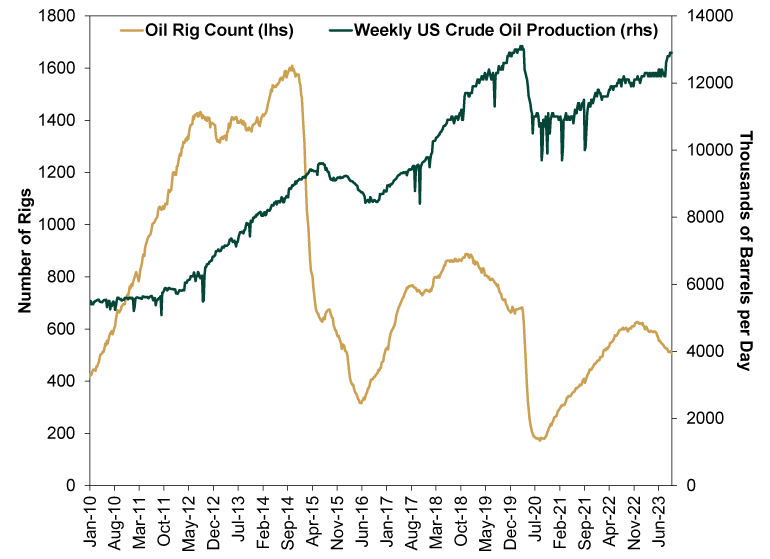General / Market Analysis
More With Less in the US Oil Patch
Rising production defies falling rig counts.
Oil prices may be down nearly -$10 per barrel since late September’s highs, but concerns over high prices haven’t abated.[i] Nor have supply concerns, with the prospect of new sanctions on Iran taking more exports off the table looming large. In our recent energy market coverage, we have noted that production increases in non-OPEC countries—most notably the US—are an underappreciated supply cushion in the wake of Saudi Arabia and Russia’s recent output cuts. Weekly US crude output is inching back to record highs, and the US Energy Information Administration reckons it will get there next year. But some warn this hope could prove far-fetched, arguing falling oil rig counts will curtail production growth (thus sending prices higher and, presumably, harming the economy and stocks). Are they right?
We don’t think so. Exhibit 1 shows weekly US oil production and rig counts since the dawn of the shale boom in 2010. As you will see, production has become increasingly detached from rig count in the past few years.
Exhibit 1: US Oil Production’s Waning Dependence on Rig Count

Source: FactSet, as of 10/9/2023. Weekly rotary oil rig count and crude oil production, 12/31/2009 – 9/29/2023.
In the shale boom’s early days, rig count was a pretty reliable leading indicator of production, with its rises and falls preceding corresponding ups and downs in output by a few months. But after oil prices crashed in 2015, the relationship deteriorated. We think this stems, in large part, from the massive efficiency gains oil producers made while prices were low—necessary to cut costs and ensure the business’s survival. Oil producers became adept at getting the maximum from existing wells, even “re-fracking” old wells to squeeze more out. Accordingly, when rig count began a long decline in late 2018, production kept soaring to new heights until lockdowns sent output and rigs off a cliff in March 2020.
Rig count’s rise from late 2020 through December 2022 accompanied a production rebound, but then the divergence returned. Year to date through Q3, the US is down -119 active oil rigs. Yet production is up by 800,000 barrels per day. Once again, it seems cost pressures are incentivizing drillers to do more with less, and there are also reports that recent mergers are helping boost efficiency further. The US’s experience in 2019 suggests this can keep going, with production continuing to rise even if rig count keeps dropping. If higher oil prices encourage producers to add more rigs, we could get an even bigger boost.
In our view, this is the silver lining of higher costs (including higher interest costs): They are an incentive to do more with less—an enforced productivity boost. In the oil world, that can mean we get more output when folks least expect it, helping keep a lid on prices. We doubt supply soars so high relative to demand that prices crash, as businesses have learned the lessons from 2015. Measured growth is the name of the game these days. But even with rig counts falling, we see a high likelihood that production keeps rising enough to keep oil in its recent price range.
[i] Source: FactSet, as of 10/11/2023.
If you would like to contact the editors responsible for this article, please message MarketMinder directly.
*The content contained in this article represents only the opinions and viewpoints of the Fisher Investments editorial staff.
Get a weekly roundup of our market insights.
Sign up for our weekly e-mail newsletter.

See Our Investment Guides
The world of investing can seem like a giant maze. Fisher Investments has developed several informational and educational guides tackling a variety of investing topics.







